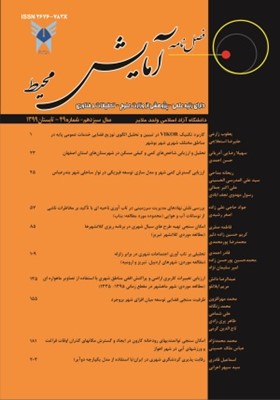ظرفیت سنجی فضایی توسعه میان افزای شهر بروجرد
محورهای موضوعی : آمایش محیطمحمد مهرافزون 1 , زنگانه احمد 2 , علی شماعی 3 , طاهر پری زادی 4 , تاج الدین کرمی 5
1 - دانشجوی دکترای جغرافیا و برنامه ریزی شهری دانشگاه خوارزمی تهران
2 - استادیارگروه جغراقیا و برنامه ریزی شهری دانشگاه خوارزمی تهران
3 - دانشیارگروه جغراقیا و برنامه ریزی شهری دانشگاه خوارزمی تهران
4 - استادیار گروه جغراقیا و برنامه ریزی شهری دانشگاه خوارزمی تهران
5 - استاد مشاور: استادیار گروه جغراقیا و برنامه ریزی شهری دانشگاه خوارزمی تهران
کلید واژه: فضا, شهر بروجرد, پراکنده رویی, توسعه میان افزا, محلات منتخب,
چکیده مقاله :
امروزه توسعه میان افزا برای شهرهایی که با محدودیت توسعه افقی و تنگناهای طبیعی مواجه می باشند رویکردی مناسب شناخته شده است.این نوع پدیده توسعه درونی از یک سو به مسئله تأمین مسکن شهری مربوط می شود و از سوی دیگربه ضرورت حفظ زمین های محدوده ی شهر و حوزه های پیرامون آن باز می گردد.بسیاری از اراضی شهری یا فاقد کاربری هستند و یا دارای کاربری های فراشهری(زندان ها و پادگان ها و غیره) می باشند و یا اینکه متناسب با ارزش زمین و تأسیسات و تجهیزات موجود،تراکم ساختمانی-جمعیتی اعمال نشده است.همین امر باعث شده که شهرهای در فضاهای پیرامون خود به گونه ای ناموزون وافراطی گسترش یابند.این در حالی است که می توان با محدود کردن گسترش حاشیه ای و اعمال سیاست های تشویقی متراکم سازی علاوه بر استفاده بهینه و حداکثری از ظرفیت های درون شهر،مانع تخریب محیط زیست و نابودی اراضی کشاورزی وزراعی حاشیه شهرها شد و با هدایت توسعه کالبدی میان افزا گامی در جهت توسعه پایدار شهری برداشت.براساس آمارهای موجود،67هزار هکتار بافت فرسوده شهرهای کشور شناسایی شده است که از این میزان؛258 هکتار آن در شهربروجرد قرار دارد و عدم توجه به توسعه میان افزا شهرهای کشور و به طور اخص شهر بروجرد می باشد.برهمین اساس هدف مقاله در راستای ظرفیت سنجی فضایی توسعه میان افزا دراراضی رها شده وبلااستفاده شهر بروجرد است و روش پژوهش به صورت توصیفی،تحلیلی وییمایشی می باشد. بنابراین با آگاهی از میزان اراضی خالی و ساخته نشده درون شهر بروجرد و برآورد میزان اراضی قابل دریافت،ضرورت استفاده بهینه از فضاهای خالی و کم بهره برداری شده و فضاهای رها شده جهت تأمین مسکن با رویکرد توسعه میان افزا شهرقابل درک است و ارجح بر توسعه پراکنده شهر در اراضی پر شیب و ناهموار با هزینه های آماده سازی بسیار بالا می باشد.
Nowadays, infill-development is considered as an appropriate approach in cities facing horizontal expansion limitation as well as natural restrictions. On the one hand, this inner development is related to providing urban housing and the necessity of preserving city proper lands and its surrounding area. Many urban lands are either non-utilized or have extra-urban land use (as prison, barracks, etc.). For some lands, building-residential density has not been implemented considering land value and existing installations and equipment. This has caused cities to expand in their suburbs in a discordant and indiscriminate manner. By restricting marginal expansion and implementing persuasive densification policies, the destruction of environment and farming lands in suburbs could be prevented; besides, the use of intra-city capacities will be optimized and maximized. Consequently, by leading infill physical expansion, steps could be taken to urban sustainable development. Based on available statistics, 67 thousand hectares of urban worn-out texture has been identified of which 258 hectares lie in Borojerd. Ignoring the infill development in cities of Iran is especially obvious in Borojerd. This study aims to assess the spatial capacity for infill development in abandoned and unused land in Borojerd. This is a descriptive- analytic survey. As the result of the study showed, by considering empty, unconstructed land inside Borojerd and by estimating receivable lands, the necessity of optimized use of empty, less utilized spaces as well as abandoned lands to provide houses and expand cities through in-fill development can be understood and preferred to sporadic urban expansion in uneven, gradient land with high preparation costs.
22. Ajay M. Garde (2004), NewUrbanism asSustainable Growth? A Supply Side Story and Its Implications for Public Policy, Journal of Planning Education and Research 24:154-170
23. Anderson, conin and Richards,Lora and Baxley, randey (2005): infill development:borriers and incentives. Truckee meadows regional planning Agency.
24. Steinacker Annete(2003), Infill Development andAffordable Housing patterns from 1996 to 2000, Urban Affairs Review, vol 38, no ,4pp 492-509.
25. Dutton, John (2000) New American Urbanism:Reforming The Suburban Metropolis, SkiraArchitectural Library.
26. Division of Historic Preservation,Wisconsin Historical Society,(2011),A Guide to Smart Growth and Cul-tural Resource Planning. Available: www.wisconsinhistory.org, Accessed4/15/2011.
27. Zhang, T., 2000, Land MarketForces and Government’s Role in Sprawl, Cities, Vol. 17
_||_

